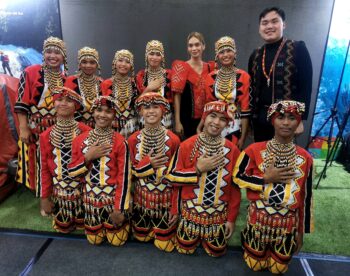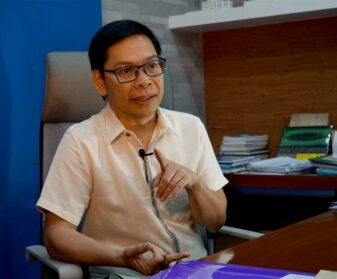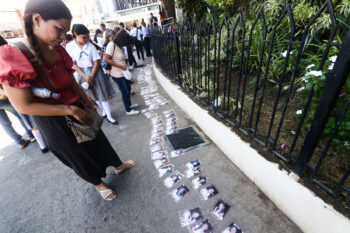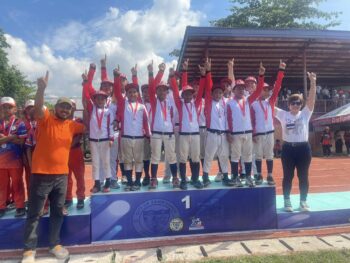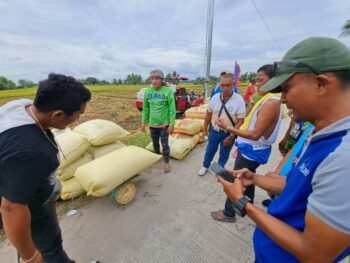[Note from the author as posted on her Facebook wall on September 19, 2016. “Below is the brief that I prepared for Translating Digong, A Forum on the Public Persona of President Rodrigo R. Duterte which took place in U.P. Mindanao this afternoon. Owing to the informal nature of the discussion, I was not able to read the brief before the audience and thus I am posting it here for better elucidation of some of the points I raised there. Sadly, there were other interesting things that I might have said in addressing some of the issues that were raised in the forum but I can no longer remember most of them. It would have been better to add them on here for more depth and relevance. Note that the opinions are mine and are based on an initial analysis of media texts that featured Digong. A more formal and rigorous approach to studying Digong’s public persona can be done in the future.” MindaNews was granted permission to re-publish this]
Good afternoon! I must admit that this is the first time I am involved in a public discourse on a political personality, the President of the country no less. My research agenda has always been about health and crisis communication and until Prof. John Bengan invited me as one of the speakers this afternoon, I refused to be a part of any discussion about President Duterte, be it his political style, agenda, and stance on the critical issues confronting the country. This reticence is due to the remote relationship between me as the observer and Digong as the observed, for having spent almost my entire life in Leyte there is less para-social interaction between us. The second reason which is related to the first one is that my understanding of the historical, political, and cultural antecedents that charted the realities of Davao City and Mindanao, in general, is limited and I fear that this would constrain my ability to immerse myself in and situate Digong’s actions and speech acts in their appropriate context.
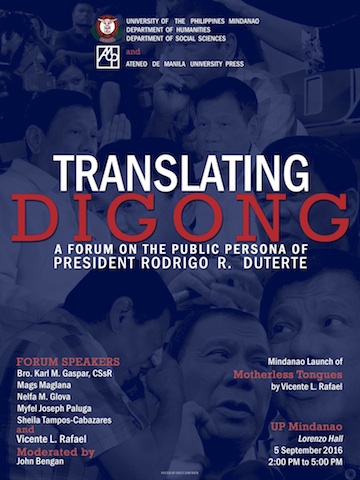 But three weeks ago, I relented because the President is a fascinating figure who reminds me of another colorful figure in the distant past of Florentine politics—Niccolo Machiavelli—who advocated political actions that were divorced from moral considerations, separating political conduct, and personal morality for what Daniel Donno referred to as the “successful practice of statecraft”. But this is not the focus of my brief talk today. My assumptions, which can be formalized later as hypotheses to be verified in a systematic study, are anchored in theoria et praxis of communication. After all, the study of public personae is also our disciplinal preoccupation.
But three weeks ago, I relented because the President is a fascinating figure who reminds me of another colorful figure in the distant past of Florentine politics—Niccolo Machiavelli—who advocated political actions that were divorced from moral considerations, separating political conduct, and personal morality for what Daniel Donno referred to as the “successful practice of statecraft”. But this is not the focus of my brief talk today. My assumptions, which can be formalized later as hypotheses to be verified in a systematic study, are anchored in theoria et praxis of communication. After all, the study of public personae is also our disciplinal preoccupation.
I would start with an operational definition of the public persona as “a person’s perceived or evident personality; personal image; or public role.” The political scientist John Corner posited that the political personae can be seen in “three spheres of action: (1) in the sphere of political institutions and processes where they build their identity as politicians, (2) in the sphere of the public and popular which is the fully mediated complex of settings where the politicians are perceived as public figures, and (3) in the private sphere where the politicians’ personal background shaped their identity and career, as well as their public projections.”
However, there are not too many of us who have access to Digong’s private life except for the information that he and his party have chosen to reveal through the years so that what we have are fragments of his private self. Confronted with this difficulty, the analysis of public personae rests on the second sphere, the mediated space of the public and the popular, and comes with the recognition that the study of a public personality cannot be isolated from his publics, the media, and the people who are responsible for seeing him or her through our perceptual sense and interpretations. The public persona may project an image but, ultimately, meanings are in people.
Given this operationalization, my thesis is this: to understand Digong’s public persona is to put him under the prism of performance and mass mediation. Digong’s public persona is largely mediated. Most of the time, the general public does not recognize this because he has a strong self-agency, he delivers, and he appears to understand the power of the medium and the psychology of the people.
Presidential campaign
His presidential campaign is a good place to start in order to explore this proposition. Long before Digong filed his candidacy, talks about the possibility that he may run for the office of the President were already brewing and his supporters around the country started to consolidate themselves. It took him a long time to confirm or deny the rumors. He made an initial statement that he was not aiming for any political position and this got his supporters, and would-be supporters, disappointed that the clamor for him to file his candidacy built up.
Seen from the lens of political communication, this was a strategy that displays a political cunning characteristic of a seasoned tactician. This tactic is reminiscent of the inoculation approach, a persuasive technique in health, crisis, and political communication. The inoculation strategy takes its analogy from the concept of vaccination—introducing bacterial strains into the body to build resistance to viruses. In communication, the inoculation process involves the introduction of conflicting information to an individual or a group in order to strengthen previously held beliefs. In so doing, a specific public’s sympathy and support for Digong intensified. These specific publics called for him to run for President such that when he finally filed his candidacy, it was not so much as him desperately wanting to run for the post but of him addressing his publics’ demand for him to serve the country because it seemed that he can deliver. This turn of events set up a contract between him and his publics. This contract, not executed in paper, but forged more on credence and trust reinforced his supporters’ para-social relationship with him which is a necessary precondition for worship and loyalty.
As a candidate for President, Digong presented a sharp contrast to the other candidates. The media captured this difference and projected it to the public. In TV and in print, he appeared to lack what Schlessinger called “definitional power.” He is Bisaya, probinsiyano—he may have looked and sounded “buki” or “taprik” beside his peers, casually dressed, loud, painfully frank, brass with a penchant for cussing and labeling people, and had no access to the instruments of the state that he could use in order to ensure his victory. Also, he deeply cared for Mindanao and the peace process, and brandished his number one agenda, war against drugs and the severe sanctions that come with it, even selling the idea of federalism on the sides.
To a specific segment of the Filipino population, he appeared to carry a shock factor that has a polarizing effect on people. But for others, he represented most of us and, at the conscious and subconscious levels, some of us identified with him. This identification gave him more persuasive power over his publics.
In return, he used this difference to his own advantage as part of his political strategies. Without definitional power he was resource poor. Those who believed him felt certain that he will not resort to heresthetic manoeuvres, “a direct manipulation of the state structure in order to achieve a specific outcome.”
This specific image of a poor candidate allowed him to position himself as a strong alternative to the stereotypical national leaders who failed to deliver their promises, and thus failed us. His campaign tagline: Change is coming! communicated this position so well.
Throughout his campaign, he seemed to have harnessed the power of the media to get himself nearer to us. But by pursuing him based on the impact of the issues that he raised or he was party of, the media also brought him closer to us. In the case of those who identified largely with him, the experience of seeing him deliver and promise to deliver largely on TV is a kind of a vicarious and rewarding experience.
By his unconventional speech, and controversial perspectives and agenda, Digong sustained media coverage by cultivating media dependence, generating newsworthiness, understanding news values, projecting difference, relying on situational credibility, and campaign ingenuity. He became our favorite subject matter in the workplace, in class, over dinner, and before we go to sleep. We allowed him to become a part of our daily realities. We allowed him to define for us the agenda of the state and attribute most of our social problems to the use and trafficking of illegal drugs.
Such is the level of trust that we bestow on him that months after, when he laid out and set into motion his anti-drug war, he did not have to ask Congress for its assent. Well, this is a different type of war that does not need Congress’ approval. Nevertheless, a part of the public has given him assent to implement his anti-drug war in full scale.
Fear appeal
However, we should also bear in mind that public assent necessitates that all of us: (1) agree on the situation itself; (2) understand the options open for a fitting response; (3) debate the costs and benefits of those options. Without these three conditions, public consent could rest on ignorance.
Digong’s rhetorics, as projected by the media, are also an interesting aspect to study. For example, the use of fear appeal has always been central in Digong’s rhetoric. Fear appeal is a rhetorical device that employs a certain amount of threat to induce people to action.
Like a strict father presiding over his big family, he threatens to punish his children for any shenanigan in the language of the neighbourhood “bugoy” or “maton”. He gives us a grim picture of that punishment, very graphic at that, though the media also gave us a graphic image of those sanctions, and reads a drug list in public. This is the technique that he used to preside over a smaller family, Davao City, then and it seemed to work for him. We saw throngs of civilians, some of them our neighbours, lining up the police stations just few weeks after Digong assumed office, in order to surrender for alleged trafficking or use of illegal drugs, cutting the long and expensive judicial process in half.
Honestly, I do not know the enduring effect of this strategy on us. The extant literature about the interconnection of fear and politics is drawn mostly from the West. The Filipino psychology of fear has not been widely explored. But if we have to look at ourselves since the time we gained consciousness, our lives are saturated with fear. We were scared by our parents into obedience, our teachers did the same, and the other individuals who were part of our development may have used a fear appeal or two to influence our thoughts and actions, notwithstanding that our environment and unfamiliar public spaces scare us. Poverty and criminality scare us as much as war and earthquake do. In a way, we have given Digong the permission to scare us.
Politicontainment
Digong is also adept at another rhetorical device which he used to connect with his publics, politicotainment, or the use of humor. He impersonated Sen. Leila de Lima in his campaign speeches, he catcalled at women journalists, and he labeled rivals and critics as “bayot”, among others. In theory, humor is used to establish a public space, a connection with people and he achieved that with his primary audience. But the use of humor in politics requires knowledge of the cultural context of the humor in order for us to see past the negative language and the accompanying humiliation.
When used in an audience who share the same context with the speaker, political humor strengthens the bond between these two elements of the communication process. However, the use of humor has its limit because those who did not share the context of the speaker would feel alienated being relegated into a realm outside of the established understanding and familiarity between the speaker and those who shared his context. This is where humor becomes divisive.
On a more important note, there have been debates over whether humor is an effective tool for social change. Most scholars seem to agree that humor does not achieve social change. It operates under the idea of social politeness being not directly confrontational but humor does not create new social discourse, it only highlights the predominant political narratives and thus, by humoring, we stay on the same boat.
Lastly, there is a limit to the use of humor when it discriminates specific social groups and discredits what that group has accomplished in terms of emancipation and equality. For example, I take offence at the President’s use of the word bayot in addressing his enemies. For me, it undermines all the struggles of civil society groups to attain equality and emancipation for specific social groups. It is specifically bothersome when double-standard references are echoed by the president of the country because it legitimizes, normalizes, not only the utterances but the overriding discriminatory mentalities.
Digong as a rhetor intersperses fear and humorous appeals into the formal and legalistic language of the chief executive of the country while occasionally lapsing into kalye Sugboanon Bisaya. The use of the latter always got him into trouble with some members of the national and international media. When Digong lapses into Sugboanon Bisaya, he has the tendency to stop midsentence and trail off.
In the ideal sense, this is part of interaction, of passive turn-taking where he invites his audience to finish his words for him, fill in the blanks with our heuristics because those who share the same language understand what he means. On the other hand, I agree with Boo Chanco in an opinion piece he wrote for the PDI that this manner of speech leaves the President open to varied interpretations by the media and the public because not all of us share his context, and more importantly, he tends to resort to this habit when he is talking about serious issues like drug trafficking, extra-judicial killings, human rights, and Marcos burial, among others.
Crisis Communication
This tendency of his embroils him in a number of crisis communication situations and got his communication team scuttling to make an apologia. Apologia, specifically defensive apologia, a public figure’s defense against possible threats to his public image and reputation, defines the crisis communication strategy of Digong lately. But his defensive apologia centers on excuses and justifications (he was taken out of context; there was a miscommunication). For the few months that he assumed office, miscommunication has been repeatedly used to address a series of crisis situations involving him.
From the purview of crisis communication, this strategy might have seemed to work now and allowed the President to transcend those issues because he established a positive image in the past. But there is also a risk in resorting to the same rhetoric over and over again. To put it simply, the President will seem to not have learned his lesson. It behooves upon those who work for the President to nip a potentially risky communication situation involving him before it could escalate into a crisis.
This time, Digong’s audience is not just the Bisayan and Mindanawon people who could, most often, fill in the mental gaps for him. This time, the communication strategy that he used effectively during his campaign should be abandoned for one that is more tailored to the daunting challenge of rebuilding the country and the public trust. He is no longer the mayor of Davao City, he is now a conduit between the entire nation and that bigger community of nations where how we communicate and negotiate our position in the global political landscape characterized by large scale power struggles may impact us significantly long after his term as President is over.
If we conduct a formal study of Digong’s rhetorics and mediation process, we may be able to uncover numerous insights about him. What I have shared this afternoon are initial and crude attempts to understand him from the lens of communication, hence I invite others to pursue this direction and shed more light on the public persona of Digong. There are many pressing issues involving the president that we need to talk about. I may hold my personal perspectives on these issues. Sadly, they are not yet the center of this initial attempt to decode Digong.
I may have wandered off from the center of our scrutiny today to make inferences and references about his publics and the media. But coming from a communication viewpoint, I believe that Digong is socially constructed and to scratch the surface of a socially constructed persona, we should allow ourselves to wander into the thoughts and sentiments of his perceivers, his co-creators of meanings, because the public persona is elusive without understanding of his or her publics and how they allowed him or her to become the way s/he is.
[MindaViews is the opinion section of MindaNews. Nelfa Glova is an assistant professor in the Communication Arts program of the University of the Philippines Mindanao. She holds a Masters of Arts in Health and Risk Communication from the Michigan State University, which she completed under a fellowship from the International Ford Foundation Fellowships Program. She also holds a Master of Science degree in Development Communication from the Visayas State University and a Bachelor of Arts degree in Political Science from the University of the Philippines Visayas (Tacloban College). Nelfa has worked as an intern and associate consultant at the Johns Hopkins Centre for Communication Programs. She has years of experience working in the field of science research and development communication, crisis and political communication]

